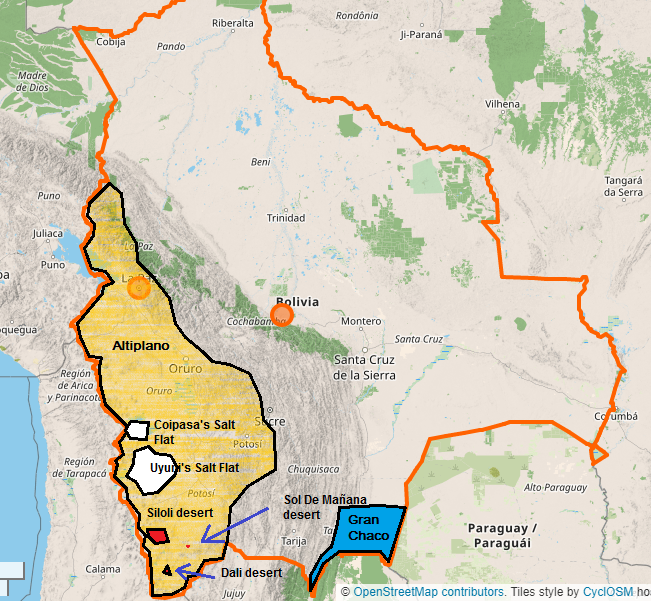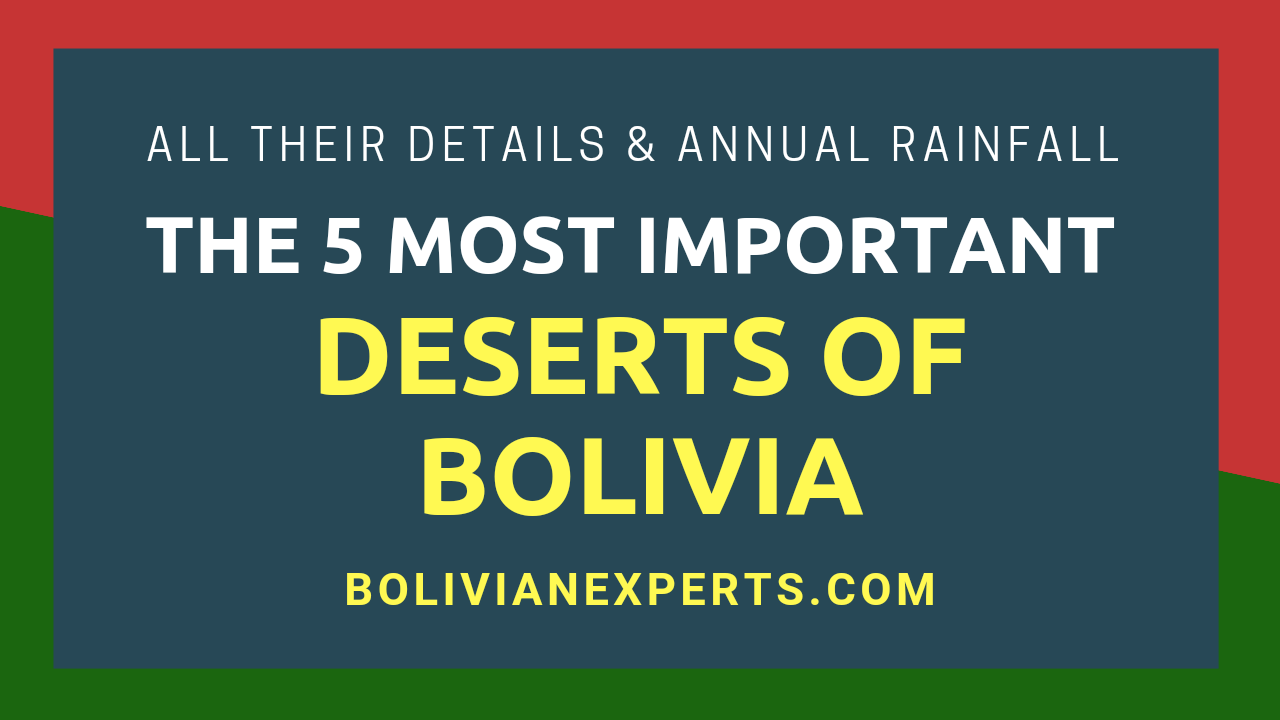Bolivia doesn’t really have a large area that can be considered a desert, in fact, less than 1% of the Bolivian territory meets the conditions for being called a true desert. But deserts exist in the country and they are also quite appreciated tourist attractions as you’ll see here. Additionally, there are pretty arid regions in the country that are worth mentioning.
In Bolivia, the 5 most important deserts are 1) Siloli Desert, 2) Dali Desert, 3) Sol De Mañana Desert, 4) Uyuni’s Salt Flat, and 5) Coipasa’s Salt Flat. The annual rainfall in these places goes from 65mm to 300mm. There also exist the Altiplano and the Gran Chaco, which are very arid large regions.
Here, we’ll be talking about the 5 most important deserts that exist in Bolivia, you will know their annual rainfall, where they are located, and for which features they stand out, among other details. You’ll also know more about both the Altiplano and Gran Chaco regions, which can be also quite arid.
How much of Bolivia is a real desert?
A) Less than 1% of Bolivia is actually a true desert
Just a tiny portion of Bolivia is a true desert, small areas where there’s almost no rainfall all year long. These are very arid lands and no flora and fauna can be found around. Furthermore, all the desert areas that exist in the country are located inside a very specific region: the southwest part of Bolivia, within the Potosí department.

This 1% of the Bolivian territory consists of some very closely located deserts, all of them in the western part of the country, in the so-called Altiplano region, and they comprehend very dry places like:
- The Siloli desert
- The Salvador Dali desert
- The Sol De Mañana desert
- The Uyuni’s Salt Flat
- The Coipasa’s Salt Flat
These places normally have between 65mm and 300mm of annual precipitation and also experience freezing temperatures at night.
We’ll be talking about all these deserts and their details in a later section.
B) 27% of Bolivia is quite arid but not a desert
In Bolivia, you’ll find that 27% of the territory is arid enough to become worth mentioning, this scarcity of rainfall and humidity exists in 2 main regions inside of the country:
- The Altiplano
- The Gran Chaco
Image: the Altiplano and the Gran Chaco
The Altiplano
The Altiplano is an endless highly elevated flat land over 11,500ft amsl (3,500m) that covers the western and southwestern part of Bolivia and surrounds all the true deserts that exist inside the country.
The Altiplano is not as arid as the deserts mentioned before, but it’s quite arid, with rainfall ranging between 100mm and 400mm each year, and the flora and fauna that exists there are pretty limited, this also triggered by the high altitude of this land.
What you are going to experience in the Altiplano and inside its cities it’s not a real lack of water supply (more than 3 million people live in this area), but almost no rainfall between May and September, but enough rainfall between October and April, also very dry looking landscapes.
The Gran Chaco
Additionally, there is another sometimes very arid region of Bolivia that is far away from the Altiplano. It’s called the Gran Chaco. This region has most of the time enough rainfall, but it also gets several droughts from time to time. This region is located in the very south of Bolivia, in the Tarija department.
These significant droughts in the Gran Chaco can appear at any time of the year, but mostly from May to December, along with very high temperatures, be careful with this possibility.
C) The rest 72% of Bolivia has enough humidity and rainfall
The rest of the Bolivian territory has enough humidity and rainfall all year long and it’s seen as wet and fertile, averaging between 500mm and 2,000mm each year. This part of Bolivia consists mostly in:
- Tropical lands in the West of the country (rainforests are everywhere there)
- Amazonian lands in the North and Northeast of the country
- Low-elevated mountain ranges, hills, and canyons are at the center of the country.
Bolivia is indeed mostly a tropical country, and at its very north it even has part of the Amazonas within its territory. It also has a corridor of rugged terrain, endless hills, and mountain ranges that cross from north to south, which are also very wet and have enough rainfall all year long.
This area of Bolivia is covered by a lot of flora and fauna and exuberant forests and jungles, tropical storms are very common, so water is everywhere in these regions.
All the true deserts that exist in Bolivia
Now, let’s see the true deserts that exist within the country. These are so arid places that can be compared to the Atacama and Sahara deserts in regards to annual rainfall.
1) The Siloli desert
This is a really arid place, maybe the driest desert of Bolivia, just behind the Atacama desert in regards to rainfall, with annual precipitation of 65mm, and an altitude from 14,800ft to 16,400ft amsl (from 4,500m to 5,000m). It’s located next to the Eduardo Avaroa National Park and it’s considered the gate to enter this park. It’s also very cold with temperatures around 37°F (3°C).
It’s a tourist place, often visited because it’s very close to other tourist places like the Eduardo Avaroa National Park, the Uyuni’s Salt Flat, and because it has an interesting rock formation named the Stone Tree.
Normally, tourist agencies in Bolivia don’t have any trouble when allowing foreigners to visit this desert, but if you get lost there, you will be in big trouble because of the cold weather, the lack of water, and with no towns or urban areas nearby, so be careful with this risk, don’t allow yourself to transit this place without proper tourist guidance.
2) The Salvador Dali desert (Pampa Jara)
This is another desert located within the Eduardo Avaroa National Park, it has an extension of about 42 sq mi (110 km2) and an annual precipitation below 100mm. This desert is a highly elevated land, with an average altitude of 15,600ft amsl (4,650m) surrounded by many volcanoes and geysers, but also very interesting rock formations:
It remembers the paintings of Salvador Dali, with landscapes very similar to these pieces of art. There is almost no flora and fauna inside this desert, and looks really arid, also with no towns or urban areas nearby. Be careful to go there without proper tourist guidance.
3) The Sol de Mañana desert
This is another desert located inside the Eduardo Avaroa National Park, it has a lot of volcanic activity, and many very active geysers that attract a lot of tourists. The land is very arid with no flora and fauna at all, the active volcanoes and rock formations are interesting things to see there.
This place is quite small, with an extension of around 0.77 sq mi (2 km2), at an altitude of 15,900ft amsl (4,850m). It’s part of the tourism you can do inside the Eduardo Avaroa National Park, always go with a proper tourist guide to these places.
4) The Uyuni’s Salt Flat
This a well-known Bolivian tourist place of Bolivia, and also a desert, because it doesn’t have any kind of flora and fauna inside its boundaries, despite having a lot more annual rainfall than the other deserts mentioned before, being this about 150mm to 250mm each year.
Furthermore, from May to August almost no rainfall will happen in this salt flat, most of the precipitation occurs at the end of the year, between September and April. The Uyuni’s Salt Flat is above 12,000ft amsl (3,650m) and has an extension of nearly 4,086 sq mi (10,582 km2).
The best time to enjoy the landscapes of the Uyuni’s Salt Flat is in the winter (from May to August) when there is almost no rainfall and the salt in the land doesn’t get wet, so it can very well mirror the sky over the salt flat, but at this time this place gets also very cold, with freezing temperatures at night.
5) The Coipasa’s Salt Flat
The Coipasa’s Salt Flat is another very large Bolivian salt flat, not as famous as the Uyuni’s Salt Flat, which also can be classified as a desert because it doesn’t contain any kind of flora and fauna, as nothing can grow in such salty terrains.
It also is quite dry, with annual precipitation of 220mm to 300mm, which happens mostly from September to April, being May to August as the dry season in this region. The Coipasa’s Salt Flat fully surrounds the Coipasa Lake, it’s over 12,000ft amsl (3,650m) and has an extension of nearly 869 sq mi (2,250 km2).
Very arid areas and regions exist in Bolivia
The Bolivian Altiplano
As we said before, this region has an altitude of 11,500ft to 14,800ft amsl (3,500m to 4,500m), and around 300 mm of annual rainfall in its north part, down to less than 100 mm at its southeast part, containing also to the Siloli and Dali deserts, both Uyuni’s and Coipasa’s salt flats and de Eduardo Avaroa National Park. It’s an endless highly elevated flat land and has an extension of 66,665 sq mi (172,662 km2).
The Gran Chaco
It’s a really hot place, droughts are common, and wildfires tend to appear there. It’s spread across 3 countries, Bolivia, Argentina, and Paraguay. It gets 600mm of annual precipitation and is called the oven of South America link as temperatures there can sometimes go up to 47°C. It has an extension of 49,326 sq mi (127,755 km2).
Conclusions:
In this note about the most prominent and important deserts in Bolivia, you have known that these do exist, but they are quite small compared to the whole Bolivian territory and occupy less than 1% of the country. You have known that all of these deserts are located in the southwestern part of the country, within the Altiplano region.
You learned that there are 3 true deserts, the Siloli desert, the Dali desert, and the Sol De Mañana desert, with an annual rainfall of between 65mm and 100mm, and 2 salt flats, the Uyuni’s Salt Flat and the Coipasa’s Salt Flat, with an annual rainfall of 150mm to 300mm that can be considered quite arid, with almost no living species inside.
Now you also know about 2 very large regions of Bolivia, the Altiplano and the Gran Chaco, that are quite dry sometimes in the year. The Altiplano almost doesn’t have rainfall between April and August and gets very dry in this month. The Gran Chaco can get sudden droughts and also get really hot temperatures that can be life-threatening.
Remember to always go with a proper tourist guide to these deserts and the Gran Chaco region, as they are very well-known tourist places in Bolivia, locations where you can face many dangers to your life if you stay there without proper tourist guidance.
We hope this information has helped you, and if you want to know more about the average rainfall in Bolivia, according to different regions in the country, and also in the most important cities, visit our dedicated guy in the following direction: The average rainfall in Bolivia, a full overview.
BolivianExperts.com, information about how to live, work, invest, and travel in Bolivia.








